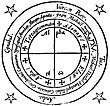White magic
This article has multiple issues. Please help improve it or discuss these issues on the talk page. (Learn how and when to remove these template messages)
|
| Part of a series on |
| Magic |
|---|
 |
White magic has traditionally referred to the use of supernatural powers or
History
Early origins
In his 1978 book, A History of White Magic, recognised occult author Gareth Knight traces the origins of white magic to early adaptations of paleolithic religion and early religious history in general, including the polytheistic traditions of Ancient Egypt and the later monotheistic ideas of Judaism and early Christianity.[3]
In particular, he traced many of the traditions of white magic to the early worship of local "gods and goddesses of fertility and vegetation who were usually worshipped at hill-top shrines" and were "attractive to a nomadic race settling down to an agricultural existence".
Early origins of white magic can also be traced back to the Cunning Folk.
During the Renaissance
By the late 15th century, natural magic "had become much discussed in high-cultural circles".
It is the coming-together of these ideas - early "natural" religions and later philosophical thinking - that Knight suggests is "at the root of the Western tradition of white magic". and night-time ritual.
Zambelli goes further and suggests that white magic, though then not specifically distinct from its counterpart black magic, grew as the more acceptable form of occult and pagan study in the era of the Inquisition and anti-witchcraft sentiment.[4] If black magic was that which involved Trithemius' invocation of demons, Ficino's "purely natural" white magic could be framed as the study of "natural" phenomena in general with no evil or irreligious intent whatsoever. Zambelli places academics like Giordano Bruno in this category of "clandestine" practitioners of magic.[4]
Modern interpretations
In his 2009 book, Magic and Alchemy,
According to Place, effectively all prehistoric
Goddess worship
Though not exclusively a female pursuit, modern white magic is often associated with stereotypically feminine concepts like that of a Mother goddess,
See also
- Gray magic – Form of supernatural magic
- Renaissance magic – Magical science during the Renaissance
- Theurgy – Practice of rituals with the intention of invoking the action/presence of one or more deities
References
- S2CID 162843793. Retrieved 15 May 2020.
- ^ Temple, Ian. Magic and the Common People of Early Modern Europe.
- ^ a b c d e A History of White Magic by Gareth Knight (Skylight Press, 2011 reprint)
- ^ a b c d e White Magic, Black Magic in the European Renaissance by Paola Zambelli (BRILL, 2007)
- ^ The Occult Sciences in the Renaissance: A Study in Intellectual Patterns by Wayne Shumaker (University of California Press, 1972)
- ^ Infobase Publishing, 2009)
- ^ a b White Magic by Marian Green (Southwater, 2004)
